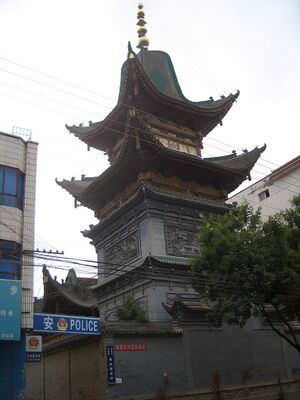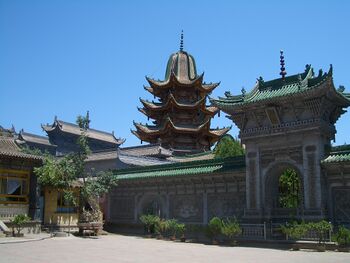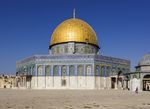گونگبـِيْ (عمارة إسلامية) Gongbei

| جزء من سلسلة عن الإسلام في الصين |
|---|
 |
|
|
Gongbei (Chinese: 拱北; pinyin: Gǒngběi؛ من فارسية: گنبد gonbad,[1] meaning "dome", "cupola"), is a term used by the Hui and Uyghur Muslim populations of China in the Northwestern region to indicate an Islamic shrine complex centered on the grave (qabr) of a Ṣūfī Muslim murs̲h̲id ("master") or walī ("saint"), typically the founder of a menhuan (a Chinese Ṣūfī ṭarīḳa, or "saintly lineage"). The grave itself usually is topped with a dome.[1][2] Similar Islamic facilities with the same purpose, known as dargāh or türbe, can be found in several other regions of the Muslim world.
Between 1958 and 1966, many Ṣūfī shrines and tombs in Ningxia and throughout Northwestern China in general were destroyed, viewed by the Chinese Communist government and authorities as relics of the old "feudal" order and symbols which the Chinese Communist Revolution (1946−1950) had attempted to eradicate through a series of atheistic and anti-religious campaigns, as well as for practical reasons ("wasting valuable farmland"). Once the right to freedom of religion became recognized once again in the 1980s, and much of the land reverted to the control of individual farmers, destroyed gongbei were often rebuilt once again.[3]
السمات
In Ningxia, the nearly 70 existing gongbei are divided into three groups.[4]
- As part of a daotang (instructional hall)
- As part of an instructional hall on the same site as a prayer hall that may be with other structures
- In combination with a mosque
When a site has as mosque, instructional hall, and a gongbei, the gongbei is set apart from the other two.[4]
انظر أيضاً
 گونگبـِيْ يو بابا في مدينة لينشيا. وتُعرف أيضاً بإسم "لاو گونگبـِيْ" و "بـِيْتشنگجياو". |
المراجع
- ^ أ ب Lipman, Jonathan Neaman (1998). Familiar strangers: a history of Muslims in Northwest China. Hong Kong University Press. p. 61. ISBN 962-209-468-6.
- ^ Joseph Fletcher, The Sufi Paths (turuq) in China”, Etudes Orientales 13/14 (1994). Quoted in: Dru C. Gladney (1996). Muslim Chinese: ethnic nationalism in the People's Republic. (Volume 149 of Harvard East Asian monographs). Harvard Univ Asia Center. p. 41. ISBN 0-674-59497-5.
- ^ Gladney, Dru C. (August 1987). "Muslim Tombs and Ethnic Folklore: Charters for Hui Identity". The Journal of Asian Studies. 46 (3): 495–532. doi:10.2307/2056897. JSTOR 2056897. S2CID 163809196.
- ^ أ ب Steinhardt, Nancy Shatzman (2015). China's Early Mosques (in الإنجليزية). Edinburgh University Press. pp. 222–223. ISBN 978-0-7486-7041-3.
وصلات خارجية
 Media related to Gongbei at Wikimedia Commons
Media related to Gongbei at Wikimedia Commons
